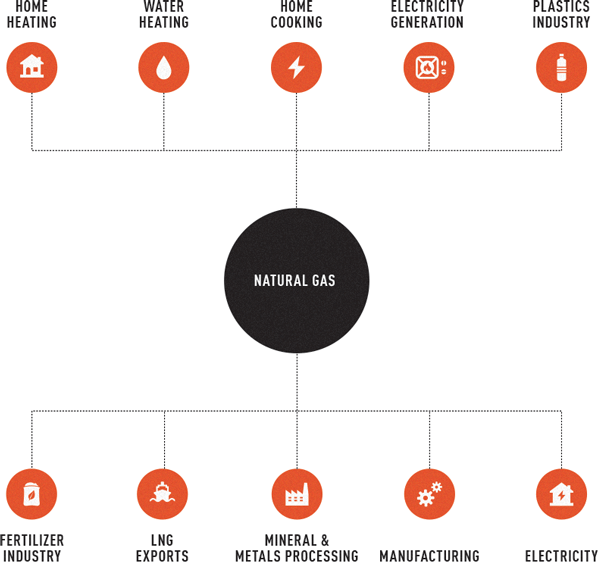The development of natural gas in Australia
What is natural gas?
Natural gas occurs in underground reservoirs and is generated by rocks formed where plant and animal matter have been trapped and exposed to heat and pressure over millions of years. It generally consists of methane and varying amounts of other gases such as nitrogen and carbon dioxide and sometimes heavier hydrocarbons such as ethane and butane.
What is it used for?
Fuels: The primary use for natural gas in Australia is electricity generation. About a fourth of Australia's primary energy consumption is generated from natural gas1. It is also widely used in homes and businesses for cooking and heating. Natural gas from Australia is also exported as liquefied natural gas (LNG) to other countries where it is primarily used for electricity generation.
Manufacturing: Natural gas is also used as a fuel in a variety of mining and manufacturing processes (for example, smelting and refining metals). Gas is used in producing a wide range of industrial products, including plastics and polymers, textiles and paints and dyes. Gas is also very important in the production of fertilisers.

Image courtesty of APPEA
How is it extracted?
Up until the 1990s in Australia, natural gas was primarily extracted from what are known as conventional reservoirs. These are made from permeable rock (typically sandstone) and readily release gas upon being drilled. The gas in these reservoirs is held as free-gas in micro-pores and sealed in by an overlying, impermeable cap-rock. The gas usually originates from ‘source rocks’ such as shales and coals located some distance from the reservoir. The gas migrates over time via natural processes into the reservoirs.
Substantial amounts of the same sort of gas (and sometimes oil) are also found in ‘unconventional’ reservoirs. Typically, these are either relatively impermeable sandstones (tight gas) or the same types of source-rocks (coal seam gas and shale gas) which feed the conventional reservoirs.
Gas from such unconventional reservoirs is generally more expensive to produce. Often less gas per well can be recovered and/or at lower rates. Sometimes, production needs to be stimulated through hydraulic fracturing, horizontal drilling or simply by drilling more wells.
Where in Australia is it found?
Gas was first discovered in the Roma region of Queensland in the late 1890s when a water well struck a gas pocket in a conventional sandstone reservoir. While the very large offshore oil and gas fields of the North West Shelf (WA) and the Bass Straight are widely recognised, it is less well known that conventional oil and gas reservoirs have also been developed onshore Australia for decades.
Examples of areas where onshore gas is found are the Surat and Bowen Basins (QLD), the Eromanga & Cooper Basin (QLD and SA), the Otway and Gippsland Basins (VIC), the Gunnedah Basin (NSW), the Amadeus Basin (NT), and the Perth Basin (WA).

Please download the high-quality version of the map:
AEMO Gas Map 2021 (PDF, 681.8 KB)
Image ' Australian Energy Market Operator (AEMO).
How much gas is produced?
To see how much gas has been produced in Queensland, go to the website of the Queensland Government, who updates the statistics of the coal seam gas production in Queensland every six months.
From this website, the Queensland Gas Supply Demand Action Plan can also be accessed.
Why did the Queensland onshore industry develop so quickly in the 2010s?
From around the mid-1990s gas began to be produced from (coal seam gas or CGS) in the Bowen and Surat basins for domestic consumption. Queensland CGS accounts for the majority of Queensland's domestic gas supply in addition to supplying other domestic gas markets.
During the mid-2000s, the global LNG price rose significantly. This created a situation in which previously marginal gas might become commercial. In 2007, the first of several proposals was put forward to convert coal seam gas to LNG and export it to attract global prices.
Government approval of three major CSG-LNG export projects in Queensland paved the way for large amounts of gas that was likely to be otherwise non-commercial in the Australian domestic market to be developed from CSG in the Surat and Bowen. This was the first time in the world that gas from unconventional reservoirs has been used for LNG export. Meanwhile, reserves of shale gas, tight gas and coal seam gas are being explored in several other regions of Australia.
References
- Bureau of Resource and Energy Economics, 2015 Australian energy statistics data.
- Australian Government, Department of Industry, Bureau of Resources and Energy Economics, Eastern Australian Domestic Gas Market Study.
Overview of natural gas in Queensland
Towler B, Firouzi M, Underschultz J, Rifkin W, Garnett A, Schultz H, Esterle J, Tyson S & Witt K (2016), An overview of the coal seam gas developments in Queensland, Journal of Natural Gas Science and Engineering, April 2016, vol 31, pp 249-271.
Fact sheets
A selection of fact sheets available on topics related to CSG development from both government bodies and industry.
Coal Seam Gas
- What is unconventional gas? (CSIRO)
Hydraulic Fracturing (Fraccing)
- What is hydraulic fracturing? (CSIRO)
- Fraccing and B-TEX fact sheet (Queensland Government)
Co-produced water
- CSG water management | Webpage (Queensland Government)
Impacts on groundwater
- Connectivity between water systems (IESC)
- Understanding the groundwater impacts of coal seam gas (National Centre for Groundwater Research and Training)
- Underground water impact reports (Queensland Government)
- Surat Underground Water Impact Report 2016 (Queensland Government)
- Integrated laws to manage water impacts (Queensland Government)
Land subsidence
Drilling
- Characterisation and Management of Drilling Fluids and Cuttings in the Petroleum Industry (Queensland Government)
